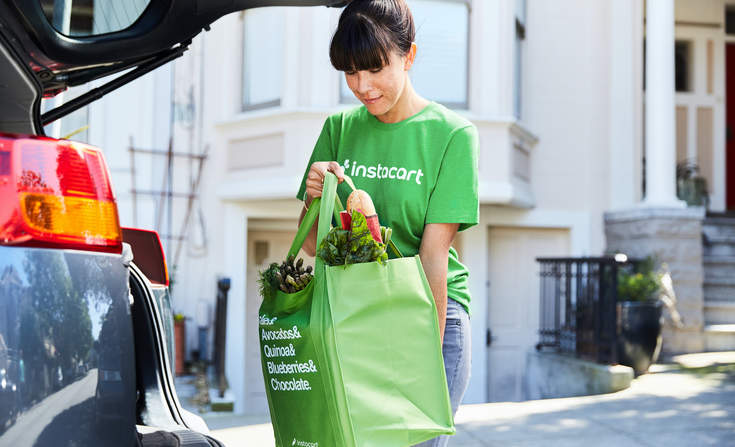
By Jim Giles
Welcome to part two of our forecasting exercise. Last week, we looked at a post-pandemic food system that’s a lot like a microgrid: decentralized; diverse; and more resilient to shocks. This week, I’m imagining a future in which coronavirus has dramatically reshaped how we buy food.
Back in the BC era — before coronavirus — consumers had limited interest in buying food online. When the World Economic Forum looked at the frequency of online purchases in 17 product categories, groceries came last (PDF). Two-thirds of us have bought electronics online; for groceries, the figure is 16 percent.
That was then. Order volume at Instacart is up a staggering 500 percent from this time last year, prompting the company to grow its army of shoppers from 200,000 to more than 750,000. At Whole Foods, deliveries are so hard to book that developers have built bots that automatically grab new slots. Small producers that serve local markets also report being overwhelmed with online orders.
This is likely an inflection point. Sure, some people will return to stores as the coronavirus threat wanes. But having tried it, I bet that many shoppers will find online grocery ordering quicker and easier. It’s therefore vital that we figure out what this shift means for the sustainability of the food system.
There’s more than one metric to consider, but this week I’m focusing on greenhouse gas emissions. The shift should be good news, because having a truck drop off multiple orders is more efficient than everyone driving their vehicle to the store. Figures from the United Kingdom show that a typical delivery route for parcels involves 120 drop-offs; an individual traveling to the store would produce more than 20 times as much carbon dioxide.
The bad news is that the reality of online groceries is nothing like that. Instacart orders are delivered not by trucks but by gig workers in regular cars. “Some delivery services are not on the consolidation model,” says Anne Goodchild, an expert on urban freight at the University of Washington. “It’s just someone else doing what you would have done.” And even when orders are grouped together in larger vehicles, our desire to have food arrive within hours rather than days also erodes potential emissions savings.
Where does this leave us? The surge in online grocery ordering has been so quick that I’m not aware of any academic studies that have assessed its impacts. But the problems with the Instacart model and short delivery times suggest that we could be squandering a huge opportunity. Shoppers are moving online in droves, but the potential emission savings may be missed.
As I was mulling this maddening situation, I remembered how ride-share apps and electric scooters arrived in our cities. In both cases, a small number of startups — Uber, Lyft, Lime, Jump — deployed oodles of venture capital to grab market share. They flooded streets with vehicles and scattered scooters across sidewalks. Only later did they engage in discussions about the impact of their services. I fear something similar is happening with grocery delivery. As the delivery companies scramble to respond to consumer demand, they’re changing our cities with minimal input from elected officials.
The absence of government input isn’t just about the gung-ho attitude of the delivery services. City officials are missing out because they haven’t figured out what to do. “I could count on two hands the number of North American cities that have a freight plan,” Goodchild told me. And some of those plans, she added, aren’t really plans — just attempts to bring together relevant data.
It doesn’t have to be like this. In the World Economic Forum study I mentioned above, researchers described how a bunch of within-reach measures, including using electric vehicles for deliveries and better load-pooling, can reduce emissions from last-mile delivery by 30 percent compared to a business-as-usual scenario. Other work has shown that cargo bikes can bring additional benefits in dense cities.
Strategies are out there; they’re just not being implemented. What we need is for city governments and delivery companies to start working together to design last-mile systems that serve residents’ needs, fairly reward workers and lower emissions.